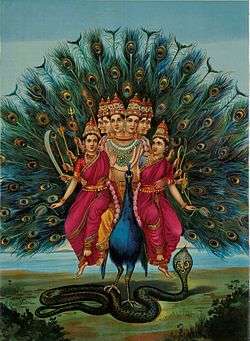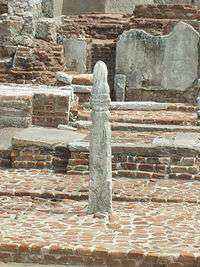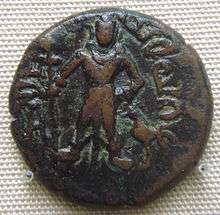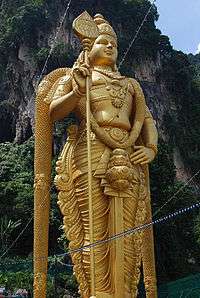Vel
| Vel | |
|---|---|
|
Murugan statue with Vel at Batu Caves, Malaysia | |
| Type | Spear |
| Place of origin | India |
Vel (Tamil: வேல்) is a divine javelin (spear) associated with Hindu war god Karthikeya. Spears used by ancient Tamils in warfare were also commonly referred to by this name.
| Part of the series on |
| Kaumaram |
|---|
 |
|
Six sacred abodes |
|
Hindu Mythology
According to Hindu mythology, Goddess Parvati presented the Vel to her son Murugan as an embodiment of her shakti or power in order to vanquish the evil asura Soorapadman. According to the Skanda Purana, in the war between Murugan and Soorapadman, Murugan used the Vel to defeat all the evil forces of Soorapadman. When a complete defeat for Soorapadman was imminent, the asura transformed himself into a huge mango tree to evade detection by Murugan. Murugan hurled his Vel and split the mango tree into two halves, one becoming Seval (a rooster) and the other Mayil (a peacock). Henceforth, the peacock became his vahana or mount and the rooster became the emblem on his battle flag.


Vel, as a symbol of divinity, is an object of worship in the temples dedicated to Murugan. The annual Thaipusam festival celebrates the occasion when Murugan received the divine Vel from his mother. During this festival, some of the devotees pierce their skin, tongue or cheeks with vel skewers while they undertake a procession towards the Murugan temple.
As a weapon
The Vel was extensively used by the Tamil Hindu castes as a weapon[1] "Vetrivel! Veeravel!" ("Victorious Vel, Courageous Vel") was a commonly used battle cry in ancient Tamil Nadu.
See also
References
- ↑ "Powerful Spiritual & Physical Weapons from Ancient Hindu Texts". The Chakra News. Retrieved 2012-08-05.
